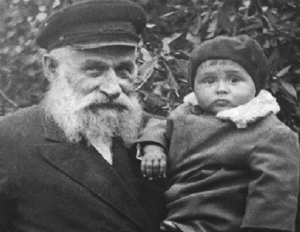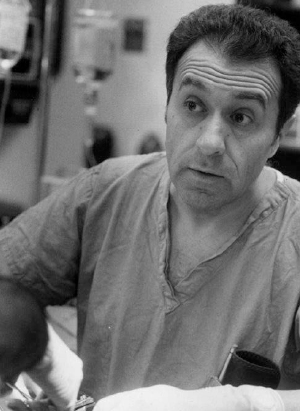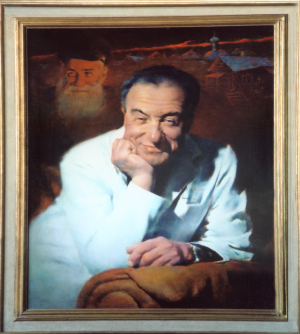Dr. Simon Gelman: A Person of Integrity and Honor, a Menschby Lisa Wise-Faberowski, MD, MS, FAAP
 Dr. Simon Gelman Dr. Simon GelmanDr. Simon Gelman was born in Leningrad, Russia in 1936. His family lived under the rule of Joseph Stalin until 1953. Despite dealing with the difficulties of World War II, his Jewish family faced their own difficulties in a communist country. The reality of discrimination was a common thread that entwined and shaped Gelman’s life.  Dr. Gelman at three years old with his grandfather Joseph Gelman Dr. Gelman at three years old with his grandfather Joseph GelmanBefore the Russian Revolution in 1917, Jewish people were segregated into small towns and villages in the western Soviet Union, “shtetls”. As a result of the Russian Revolution, cities were left desolate. Jewish people could, and many did, including Gelman’s parents, who were very young then, move to Leningrad. During the 1920s-1930s, capitalism was frowned upon in the Soviet Union. Because Gelman’s grandparents were small business owners and had others working for them, their children, Gelman’s parents, were not given the same opportunities in education as was others. Just before World War II, government sponsored anti-Semitism began, after Hitler and Stalin signed an agreement. This agreement was accompanied by a secret joint agreement that would lead to the extermination of the Jews. This agreement was never openly published or recognized by the Soviet or even later Russian governments. Stalin conducted extreme anti-Semitism despite the WW2 agreement and had planned complete displacement of the Jews to Siberia. Calculation at that time suggested that half of them would die from cold on the way. The last event, 1952 – 1953, was the trial of Jewish doctors “murderers in white coats” they were called. However, Stalin’s death on March 5 saved them. Though education was available to all individuals in the Soviet Union, it was limited by quotas. Thus, in areas with a larger Jewish population only a small percent were given the opportunity for an education. Education in engineering was considered prestigious and often difficult to obtain for those who were Jews. Medicine was a position of servitude with very limited resources. Despite this adversity, Dr. Gelman was able to receive an education with medical training at St. Petersburg State Medical School.  Maria Gelman and Dr. Gelman in Japan in 1990 Maria Gelman and Dr. Gelman in Japan in 1990In medical school, he met his now wife of 60 years, Maria. As is true for all residents of the Soviet Union, after receiving a government sponsored education, one is expected to provide three years of community service. Gelman, because he was Jewish, was sent to a community west of the Ural Mountains, surrounded by concentration camps, Syktyvkar. Syktyvkar was on the westside and Siberia was on the eastside of the Ural Mountains. His devoted wife, life companion, went with him. They were there from 1959-1962. While in Syktyvkar, Maria was instrumental in helping her husband overcome his speech impediment, stuttering. Overcoming his insecurities, related to his speech impediment, transformed Simon Gelman. The once insecure introvert became a confident extrovert. Though Gelman was wanted as a surgical officer by the Chairs in both the Departments of Surgery and Departments of Obstetrics and Gynecology in 1959; these positions were not approved though, because he was Jewish. After completing his three years of government service, Gelman could not find a job as a surgeon in 1962. In 1963, Gelman pursued a career in anesthesiology, which at the time was a part of the Department of Surgery. In 1973, during the Yom Kippur War, he immigrated with his wife to Israel. In 1976, he was recruited to Case Western University, Cleveland, Ohio by Dr. Edward Ernst. He repeated his anesthesia training at Case Western University in Cleveland, Ohio. However, Dr. Ernst was recruited to be the Department Chair at the University of Alabama in 1977. Gelman followed Dr. Ernst and completed his anesthesia training at the University of Alabama, Birmingham in 1979. His perseverance, despite adversity, is not withstanding. It was a steep learning trajectory for Dr. Gelman, as English was not his native language and the process of research funding in the United States differed from the Soviet Union. In the Soviet Union, research funding came from the president of the medical school. In his 14 years at the University of Alabama, he became Professor of Biophysics and Anesthesiology, published several manuscripts in transplantation, the effects of aortic cross-clamping and liver disease. He was NIH funded as a principal investigator from 1985-1990. Gelman was also the Vice Chairman of research. According to NIH printout at that time, he brought the level of departmental NIH funding to second in the nation ($2,000,000), Johns Hopkins being first ($5,000,000) in anesthesiology. In 1989, when Dr. Ernst resigned, Gelman became the Chairman of the Department of Anesthesiology at the University of Alabama. During his 3 years as Chair, he faced difficulties in the recruitment of scientists as The University of Alabama was an isolated institution.  Simon Gelman, M.D., Ph.D., F.A.N.Z.C.A., in the mid-1980s conducting an experiment. Simon Gelman, M.D., Ph.D., F.A.N.Z.C.A., in the mid-1980s conducting an experiment.Through a national search in 1992, Dr. Simon Gelman became the first Covino-Vandam chair of anesthesia at the Brigham and Women’s Hospital. The Brigham and Women’s Hospital Department of Anesthesiology had a long succession of Chairman, who have made a significant impact to the specialty of anesthesia. Dr. Leroy David Vandam was chairman from 1954-1978 and Dr. Benjamin Gene Covino was chairman from 1979-1991. The contributions to the specialty of anesthesia by these two individuals led to the establishment of the first endowed Chair of Anesthesia at Brigham and Women’s Hospital. Though, the endowed chair provided some seed money, the hospital provided a large share of the funds which allowed Gelman to recruit young bright scientists.  This portrait was contracted by the BWH and the Department of Anesthesiology, Perioperative and Pain Medicine at the time Dr. Gelman stepped down from the chairmanship in 2002. The portrait was painted by his very good friend, well recognized artist, Marc Klionsky, and published in a book about Mr. Klionsky. In the background of the portrait is Dr. Gelman’s grandfather, who lived in a shtetl and worked in a mill; a reminder of Dr. Gelman’s roots. Adapting to the elite culture of Boston was not difficult, though not as straight forward as Alabama. Brigham and Women’s was part of the Harvard teaching system. Harvard was one of six medical schools within the state. There was a lot of competition for funding with little assistance from the state of Massachusetts. Physician salaries were low and competition with higher salaries that could be achieved in private practice was difficult. During his tenure, ending in 2002, Dr. Gelman was the first to conceptualize translational research in a Department of anesthesia. Gelman was able to bring basic science into a clinical reality through a collaboration of basic scientists with anesthesia clinicians. With his participation came the formation of the Brigham and Women’s Physicians Organization and a merge with Massachusetts General to form Partners Healthcare. Dr. Gelman is the third largest lifetime donor to the Foundation for Anesthesia Education and Research (FAER). His dedication is a reflection of not only of his belief in the pursuit of excellence in anesthesiology research, but also his humble beginnings. At the age of 82, he is a devoted husband, father of two sons and the grandfather to six grandchildren. Though he has more than a 130 visiting professorships and more than 200 publications, he continues working full-time. He has been the editor of several well-known anesthesia journals and has a named lecture and fellowship at the Brigham and Women’s Hospital. Both at the University of Alabama and the Brigham and Women’s Hospital has a named endowed chair. Most of all he remains the humble man, the Mensch, who either directly or indirectly has influenced the lives of many of us in the field of anesthesiology and medicine. Author |


